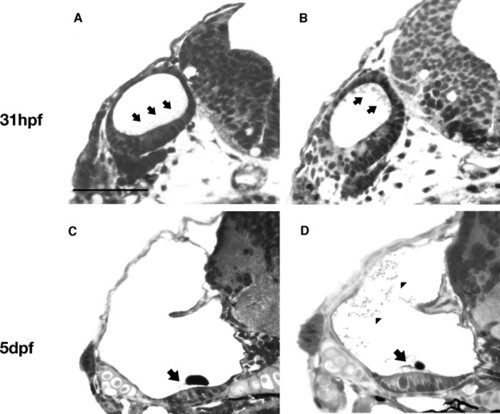- Title
-
The zebrafish gene claudinj is essential for normal ear function and important for the formation of the otoliths
- Authors
- Hardison, A.L., Lichten, L., Banerjee-Basu, S., Becker, T.S., and Burgess, S.M.
- Source
- Full text @ Mech. Dev.
|
cldnj mutant embryos have reduced otoliths. All images are lateral views of the zebrafish body at the level of the otic vesicle, with the head to the left and the tail to the right. (A–D) Photos of wildtype and mutant ears in the first 2 days of development. (A) 24 hpf lateral view of the zebrafish wildtype ear. Otoliths marked with red arrowheads. (B) 24 hpf lateral view of a cldnj mutant ear. Red arrowheads mark otoliths. (C) Wildtype ear, lateral view at 48 hpf. Red arrowhead marks otolith. (D) cldnj mutant ear, lateral view at 48 hpf. Red arrowhead marks otolith. (E,F) Morpholino phenocopy of cldnj mutation. At 24 hpf cldnj-MO is identical to the mutant phenotype, at 48 h the otoliths in the morpholino injected embryos is intermediate between the mutant and wildtype otolith size. Scale bar=100 μm. |
|
Histological sections of wildtype and cldnj embryos at 31 hpf and 5 dpf. Orientation is a cross-section of the head with the ectoderm to the left. The otic vesicle is the oval shape at 31 hpf (with the hindbrain to the right) and at 5 dpf it is the large cavity with part of the semicircular canal tissue visible as a projection into the cavity. (A) Histological cross-section through the zebrafish head of wildtype otic vesicle at 31 hpf. Black arrows indicate the ‘haze’ of otolith particles distributed along the ventral-lateral region of the vesicle. (B) cldnj mutant embryo. Otolith material appears as larger granules distributed throughout the vesicle (black arrows). (C) Wildtype ear at 5 dpf. Black arrow indicates the hair cell bundles attached to the fully formed otolith. (D) cldnj mutant ear at 5 dpf. Black arrow points to the normal appearing hair cell bundles attached to a reduced otolith. Arrowheads point to the unincorporated otolith particles still present in the endolymph. Scale bar=100 μm. |
|
The zebrafish gene claudinj is mutated in cldnj embryos. (A) Diagram illustrating the location of the proviral integration. cldnj is an intron-less gene so the integration is in the same location in the genomic sequence as the mRNA. Primer locations used in the genotyping are marked by arrowheads. (B) Genotypes of nine mutant embryos, only the mutant allele present. (C) Genotypes of nine wildtype siblings. Four wildtype and five heterozygous fish. (D) Pustell DNA matrix comparison of the sequence of EST clone FC30g01 to the published claudinj sequence. An approximately 1 kb insert in the 3′ UTR is present in the cldnj sequence but not in the EST clone. |
|
In situ hybridizations showed cldnj expression in the ear and hindbrain. (A) Seven somite embryo, dorsal view (B) 18 hpf embryo, lateral view low magnification. (C) 18 hpf embryo, dorsal view of head, note weak staining throughout brain marked by red arrow. (D) 18 hpf embryo, dorsal view of otic vesicles. (E) High magnification of 18 hpf embryo, dorsal view of otic vesicles (F) 31 hpf embryo, otic vesicles and hindbrain, posterior view imaging directly through the hindbrain (similar to histological cross-sections in Fig. 2), red arrowhead indicates staining is dorso-lateral in the vesicle. Red arrow marks increased signal of cldnj at the midline of the brain. (G) 31 hpf embryo, lateral view with cldnj staining in the otic placode. (H) 48 hpf embryo, lateral view. Scale bar=100 μm. EXPRESSION / LABELING:
|
Reprinted from Mechanisms of Development, 122(7-8), Hardison, A.L., Lichten, L., Banerjee-Basu, S., Becker, T.S., and Burgess, S.M., The zebrafish gene claudinj is essential for normal ear function and important for the formation of the otoliths, 949-958, Copyright (2005) with permission from Elsevier. Full text @ Mech. Dev.




